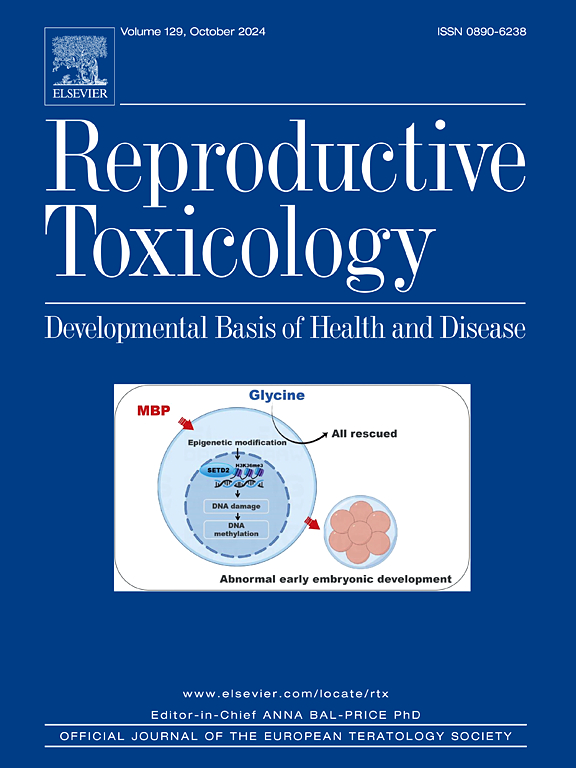非人灵长类动物发育和生殖毒性研究中与免疫原性相关的胎盘梗死和流产:提出的机制和对研究解释的影响
IF 3.3
4区 医学
Q2 REPRODUCTIVE BIOLOGY
引用次数: 0
摘要
先前对食蟹猴进行的3项生物治疗药物发育毒性研究(1项EFD, 2项ePPND)的分析表明,免疫原性与流产之间存在关联。这导致了一种假设,即给予怀孕的非人灵长类动物(NHPs)生物治疗药物的免疫原性反应可能导致胎盘血流动力学和/或血管病理改变,导致胎盘梗死和继发于子宫胎盘灌注受损的流产。为了进一步支持这一假设,对另外17项NHP发育和生殖毒性(DART)研究进行了回顾性分析。在总共20项研究中评估的366个胎盘(2个EFD, 18个ePPND)中,18% % (n = 66)存在与母体免疫原性相关的中央胎盘梗死/血肿;这足以导致32/66(48 %)的妊娠流产。抗药物抗体阳性的女性胎盘梗死流产率为40% % (n = 8),但胎儿丢失率仅为5% %。因此,尽管在这些研究中普遍观察到免疫原性,但在大多数情况下,其对研究结果/解释的影响是可控的。在免疫介导反应的情况下,如抗药物抗体的形成和/或胎盘形态异常(如梗死),必须采取仔细考虑的证据权重方法来解释直接(与试验品相关)与间接(继发于免疫原性)的影响。如果在NHP DART研究中被测试的生物治疗药物预计具有高度免疫原性,可能会对研究解释产生混淆影响,那么在进行发育毒性测试的战略方法中,应优先考虑NHP的替代品。本文章由计算机程序翻译,如有差异,请以英文原文为准。
Immunogenicity-related placental infarcts and abortions in nonhuman primate developmental and reproductive toxicity studies: Proposed mechanism and impact on study interpretation
Previous analysis of 3 developmental toxicity studies (1 EFD, 2 ePPND) conducted in cynomolgus monkeys for biotherapeutics indicated an association between immunogenicity and abortions. This led to the hypothesis that immunogenic responses to biotherapeutics administered to pregnant nonhuman primates (NHPs) can cause altered placental hemodynamics and/or vascular pathology, resulting in placental infarcts and abortion secondary to compromised uteroplacental perfusion. Retrospective analysis of an additional 17 NHP developmental and reproductive toxicity (DART) studies was conducted for further support of this hypothesis. Of 366 placentas evaluated from the 20 total studies (2 EFD, 18 ePPND), 18 % (n = 66) had central placental infarctions/hematomas associated with maternal immunogenicity; these were significant enough to lead to abortion in 32/66 (48 %) of these pregnancies. Abortions in anti-drug antibody positive females with placental infarction were found in 40 % (n = 8) of the studies but accounted for only a 5 % fetal loss rate. Thus, although immunogenicity was commonly observed in these studies, its impact to study outcome/interpretation was manageable in most cases. In the event of immune-mediated responses such as formation of anti-drug antibodies and/or abnormal placental morphology (e.g., infarcts), it is imperative to take a carefully considered, weight-of-evidence approach to interpretation of direct (test article related) vs. indirect (secondary to immunogenicity) effects. In cases where the biotherapeutic being tested is expected to be highly immunogenic in an NHP DART study, with potential confounding impact to study interpretation, alternatives to NHPs should be given high priority in the strategic approach to developmental toxicity testing.
求助全文
通过发布文献求助,成功后即可免费获取论文全文。
去求助
来源期刊

Reproductive toxicology
生物-毒理学
CiteScore
6.50
自引率
3.00%
发文量
131
审稿时长
45 days
期刊介绍:
Drawing from a large number of disciplines, Reproductive Toxicology publishes timely, original research on the influence of chemical and physical agents on reproduction. Written by and for obstetricians, pediatricians, embryologists, teratologists, geneticists, toxicologists, andrologists, and others interested in detecting potential reproductive hazards, the journal is a forum for communication among researchers and practitioners. Articles focus on the application of in vitro, animal and clinical research to the practice of clinical medicine.
All aspects of reproduction are within the scope of Reproductive Toxicology, including the formation and maturation of male and female gametes, sexual function, the events surrounding the fusion of gametes and the development of the fertilized ovum, nourishment and transport of the conceptus within the genital tract, implantation, embryogenesis, intrauterine growth, placentation and placental function, parturition, lactation and neonatal survival. Adverse reproductive effects in males will be considered as significant as adverse effects occurring in females. To provide a balanced presentation of approaches, equal emphasis will be given to clinical and animal or in vitro work. Typical end points that will be studied by contributors include infertility, sexual dysfunction, spontaneous abortion, malformations, abnormal histogenesis, stillbirth, intrauterine growth retardation, prematurity, behavioral abnormalities, and perinatal mortality.
 求助内容:
求助内容: 应助结果提醒方式:
应助结果提醒方式:


